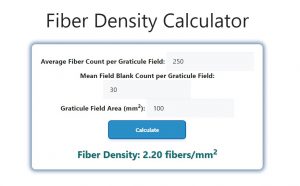About Fiber Density Calculator (Formula)
The Fiber Density Calculator is a crucial tool for researchers and professionals in various fields, including material science, biology, and environmental studies. It helps determine the density of fibers in a given sample, which is essential for analyzing the properties of materials, understanding ecological systems, and assessing the quality of textile products. By accurately calculating fiber density, you can obtain valuable insights that inform your research and decision-making processes. This article will explore the formula, usage, and practical examples of the Fiber Density Calculator.
Formula
The formula for calculating fiber density is:
Fiber Density = (Average Fiber Count – Mean Field Blank Count) / Graticule Field Area
In this formula:
- Average Fiber Count refers to the total number of fibers counted in the sample.
- Mean Field Blank Count is the average fiber count in a blank field, used as a reference to account for background noise.
- Graticule Field Area is the area of the field being examined, typically measured in square micrometers or square millimeters.
How to Use
Using the Fiber Density Calculator involves the following steps:
- Collect Sample Data: Gather your fiber samples and prepare for microscopic analysis.
- Count Fibers: Determine the Average Fiber Count by counting the number of fibers in multiple fields of view.
- Calculate Mean Field Blank Count: Conduct a similar count in a blank field to obtain the Mean Field Blank Count.
- Measure Graticule Field Area: Record the area of the field being analyzed, using a calibrated microscope reticle if necessary.
- Input Values: Enter the Average Fiber Count, Mean Field Blank Count, and Graticule Field Area into the calculator.
- Calculate: Click the “Calculate” button to obtain the fiber density value.
- Analyze Results: Review the output to understand the fiber density, which can inform your research or quality assessment.
Example
For instance, suppose you have the following data:
- Average Fiber Count: 250 fibers
- Mean Field Blank Count: 30 fibers
- Graticule Field Area: 100 square micrometers
Using the formula:
Fiber Density = (250 – 30) / 100
Fiber Density = 220 / 100
Fiber Density = 2.2 fibers per square micrometer
In this example, the fiber density of the sample would be 2.2 fibers per square micrometer.

FAQs
- What is fiber density?
Fiber density is the measurement of the number of fibers in a given area, which helps assess material properties and quality. - Why is fiber density important?
Understanding fiber density aids in evaluating the structural integrity, durability, and overall quality of materials. - How do I collect fiber samples?
Use appropriate sampling methods depending on the material, ensuring a representative sample for accurate analysis. - What equipment do I need to measure fiber density?
A microscope for viewing fibers, a reticle for measuring field areas, and a calculator for computing density. - Can I use this calculator for different types of fibers?
Yes, the Fiber Density Calculator is versatile and can be applied to various types of fibers, including natural and synthetic. - How often should I measure fiber density?
Regular measurements are advisable, especially when assessing changes in production quality or material properties. - What is the significance of the mean field blank count?
The mean field blank count accounts for background fibers and noise, ensuring a more accurate density measurement. - How do I improve the accuracy of my fiber counts?
Count fibers in multiple fields of view and ensure proper calibration of your microscope to enhance accuracy. - Can I calculate fiber density manually?
Yes, you can manually calculate it using the formula, but the calculator streamlines the process and reduces errors. - What industries use fiber density analysis?
Industries such as textiles, materials science, environmental monitoring, and agriculture frequently use fiber density analysis. - Is there a standard fiber density for specific materials?
Yes, different materials have typical fiber density ranges, which can be referenced for quality control. - What are the common applications of fiber density data?
Applications include quality control in textiles, research in ecology, and material characterization in engineering. - How can fiber density impact product performance?
Higher fiber density can enhance durability and strength, while lower density may affect the product’s performance. - What challenges might I face when measuring fiber density?
Challenges include accurate counting, background interference, and variability in fiber distribution. - Can fiber density be affected by environmental conditions?
Yes, factors like humidity and temperature can influence fiber characteristics and density. - What should I do if my fiber density results are inconsistent?
Review your counting methods and ensure proper sample preparation to achieve consistent results. - Can this calculator be used for educational purposes?
Absolutely! It’s a great tool for students and educators in biology, materials science, and textile engineering. - How do I interpret my fiber density results?
Compare your results against established norms for the specific material to assess quality and performance. - Can I use the calculator for non-fiber materials?
The calculator is designed specifically for fiber density; other materials may require different calculations. - What resources are available for further learning about fiber density?
Academic journals, textbooks, and industry publications provide extensive information on fiber density analysis.
Conclusion
The Fiber Density Calculator is an invaluable tool for anyone involved in material analysis and quality control. By accurately measuring fiber density, researchers and professionals can gain essential insights into material properties, enhance product quality, and support better decision-making. Whether you’re in textiles, environmental science, or another field, using this calculator can greatly improve the efficiency and accuracy of your fiber analysis.